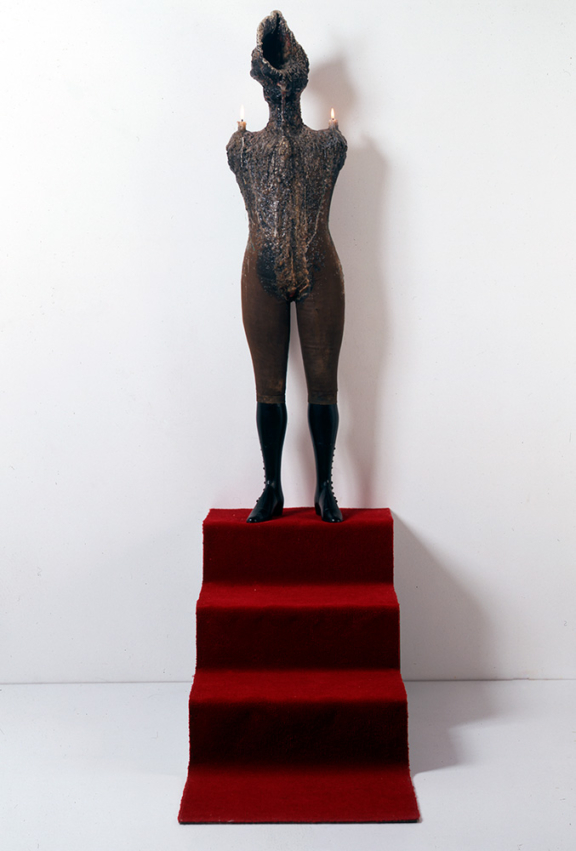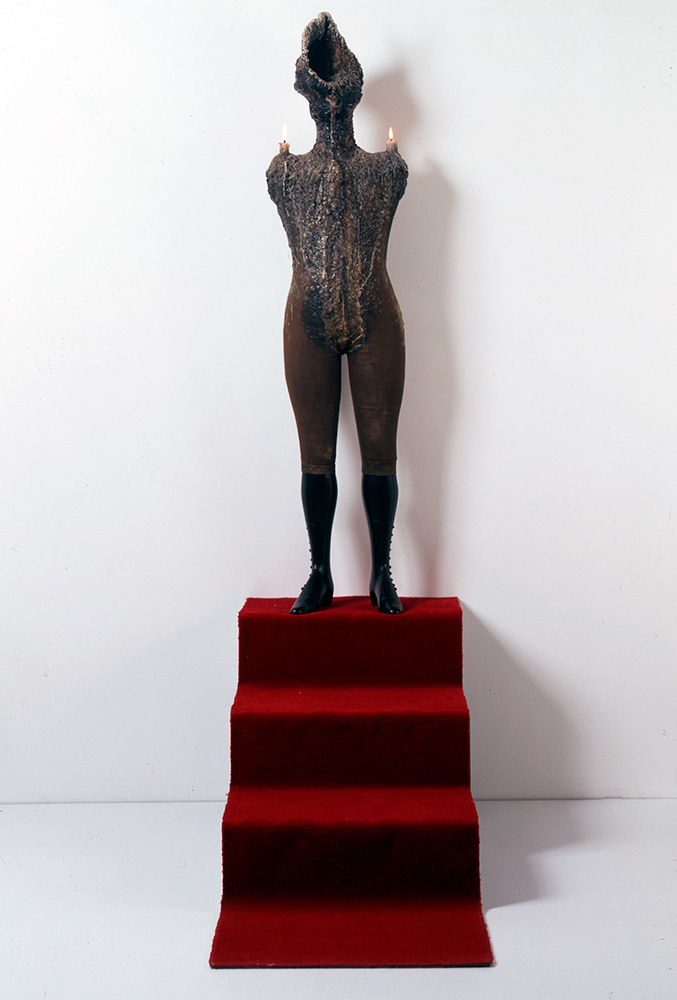
- 1952
- Wax, Candle, Mannequin and Whelk
- Mounting
- Inv. 82E839
Marcelino Vespeira
O Menino Imperativo
Vespeira’s accession to the Surrealist movement in 1947 saw the artist’s work take on a tone that was simultaneously ironic and erotic, and is evident in both his paintings and objects. While his paintings reveal a more overt formal, luminous and chromatic sensuality, his objects are particularly replete with irony and sarcasm, allowing the artist to express his distrust and dislike of the ruling power. An example of this is his sculpture Menino Imperativo (Imperative Boy) (1952), exhibited for the first time in what was also his first solo exhibition, at the Casa Jalco, a furniture house in Chiado, Lisbon, which opened its doors to Vespeira, Fernando Lemos and Fernando Azevedo, who held three solo exhibitions there at the same time.
Created in the wake of yet another speech by Salazar, in which the President of the Council mused over the needs of the nation, the Menino Imperativo appears as a manifesto of poetic freedom.
A small, armless mannequin with a conch shell (a metaphor for the wind and freedom) for its head, hushed and spectral in appearance, like a figure escaped from a dream, and with its torso covered in wax and carrying the stump of a candle on its shoulder – which was lit at the 1952 exhibition, heightening its touching, dreamlike quality – stands at the top of a small staircase covered in a dark red carpet. An indefinite figure that seems to invite viewers to a place that only exists in their own imagination, a poetic game based on the bitter political vicissitudes of the time, the Imperative Boy puts the realm of dreams and surrealism above the failure of imagination exhibited by those in power.
Emília Ferreira
March 2013
| Type | Value | Unit | Section |
| Height | 176 | cm | |
| Height | 130 | cm | |
| Depth | 22 | cm | |
| Depth | 113,5 | cm | |
| Height | 46 | cm | |
| Width | 31 | cm | |
| Width | 47 | cm |
| Type | Acquisition |
| Heimo Zobernig e a Colecção do Centro de Arte Moderna da Fundação Calouste Gulbenkian/ Heimo Zobernig and the Collection of the Calouste Gulbenkian Foundation Modern Art Centre; Heimo Zobernig and the Tate Colllection/ Heimo Zobernig e a Colecção da Tate |
| Lisboa/ St. Ives, 2009 |
| ISBN:978-1-85437-826-2 |
| Catálogo de exposição |
| Fernando Lemos e o Surrealismo |
| Sintra Museu de Arte Moderna |
| Curator: Sintra Museu de Arte Moderna |
| 20 de Novembro de 2005 a 2 de Maio de 2006 Sintra Museu de Arte Moderna |
| Exposição que apresenta fotografias de Fernando Lemos e um núcleo de obras surrealistas nacionais e internacionais. |
| Heimo Zobernig e a Colecção do Centro de Arte Moderna da Fundação Calouste Gulbenkian |
| CAM/FCG |
| Curator: Jürgen Bock |
| 11 de Fevereiro de 2009 a 31 de Agosto Centro de Arte Moderna |
| Exposição realizada em parceria com a Tate St. Ives. Inclui obras da colecção da Tate de St. Ives, do Centro de Arte Moderna e do artista Heimo Zobernig. De 24 de Maio a 31 de Agosto de 2009 estiveram expostas apenas as obras do CAM escolhidas pelo artista. |
| Surrealismo em Portugal 1934-1952 |
| Gabinete das Relações Culturais Internacionais |
| Curator: Gabinete das Relações Culturais Internacionais |
| 9 de Janeiro de 2002 a 3 de Fevereiro de 2002 Circulo de Bellas Artes, Madrid |
| Exposição composta por 120 obras de arte plástica - pintura, desenho, escultura, instalações e 70 livros que testemunham o movimento artístico e literário surrealista em Portugal, enquadrando-o numa interpretação histórica e evocando a atmosfera política, social e artística da época. Entre os autores representados, figuram, designadamente, Mário Cesariny, Cruzeiro Seixas, Alexandre O'Neil, António Dacosta, Cândido Costa Pinto, Vespeira, Jorge Vieira, António Pedro, Fernando de Azevedo, José-Augusto França e Mário Henrique Leiria. |
| Surrealismo em Portugal 1934-1952 |
| Museu do Chiado |
| Curator: Museu do Chiado |
| Outubro de 2001 a Dezembro de 2001 Fundação Cupertino de Miranda |
| 2001 a 2001 MEIAC, Badajoz |
| Exposição apresentada pela Fundação Cupertino de Miranda em colaboração com o Museu do Chiado, na dita fundação e no Museo Extremeno i Iberoamericano de Arte Contemporaneo (MEIAC), em Badajoz. |
